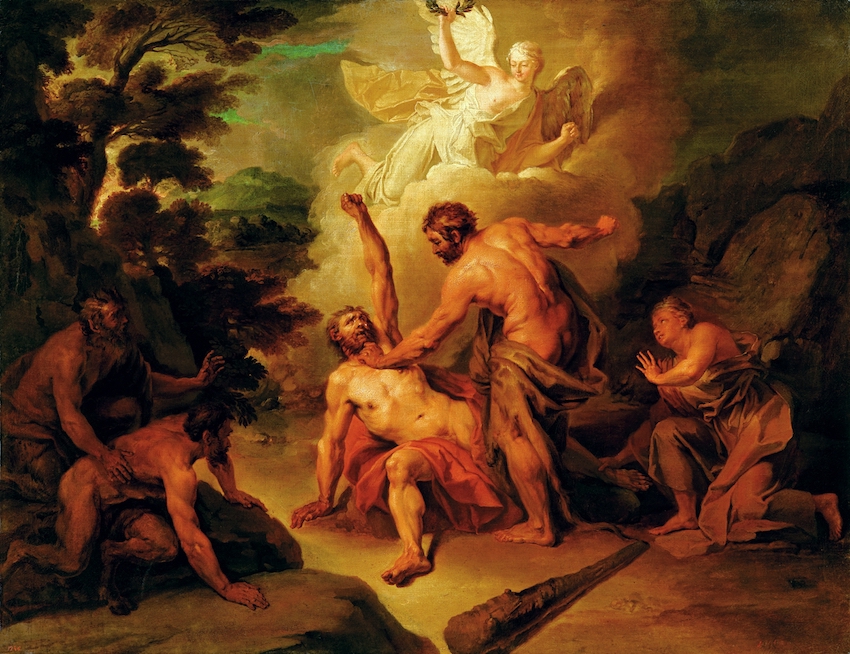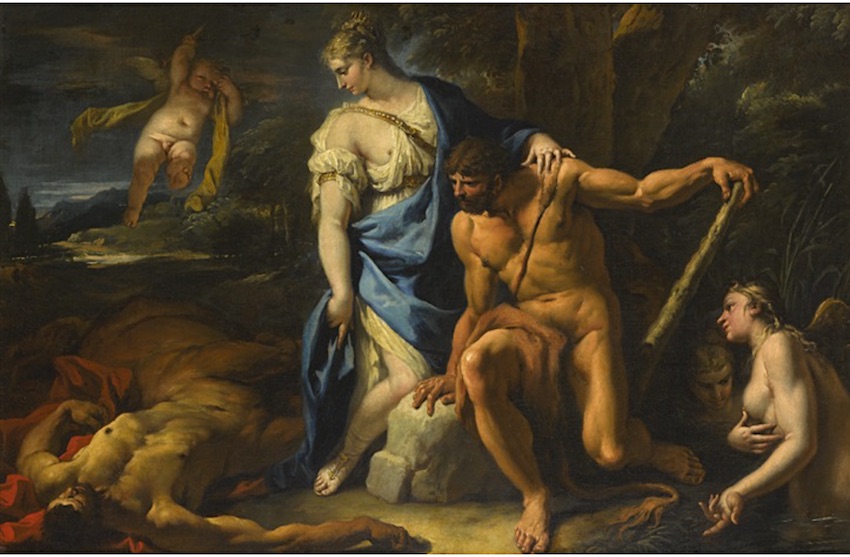Kalydon

Nicolas Bertin: Hercules fighting Achelous. Between 1715 and 1730 National Museum of Warsaw
Herakles now remembered his meeting with Meleager in the underworld during his twelfth labor, and Meleager’s recommendation that Herakles court his sister Deianeira. Leaving the Peloponnese he went to find Deianeira in Kalydon, the capital of Aitolia (the region north of Elis). The king of Kalydon was Oineus, and Deianeira was the daughter of Althaia and Oineus (or Althaia and Dionysos). When Herakles arrived he found that he would have to fight the river-god Acheloos, who also wanted to marry Deianeira. In their battle Acheloos (who, like all water-deities, could transform himself into any shape) changed himself into a bull, but Herakles broke off his right horn and won the contest. Acheloos asked Herakles to return his lost horn, and Herakles agreed to do so if Acheloos gave to him in exchange the horn of Amaltheia (the cornucopiae, or "horn of plenty").
Amaltheia was the goat who nursed the baby Zeus; ambrosia flowed from one of its
horns and nectar from the other. Or she was a nymph, perhaps a daughter of
Okeanos, who owned the goat, or, according to Pherekydes, she was Haimonios’
daughter and she had a bull’s horn which furnished whatever food and drink its
possessor wished. Diodoros says that Herakles gave the horn of Acheloos to the
Kalydonians, who represented it as full of every kind of autumn fruit and called
it the "horn of Amaltheia” (the Greek phrase for “horn of plenty”).
According to Ovid, Naiad nymphs received the horn of Acheloos and made it into
the cornucopiae (the Latin term for “horn of plenty”), or a Naiad nymph named
Amaltheia owned the goat which nursed the baby Zeus; when the goat broke a horn
on a tree, Amaltheia filled it with fruit and gave it to Zeus, who later made
both the goat and its horn into constellations.
Why does Acheloos, a river god whose normal shape, whatever it
might be, is certainly not a bull, want to recover his lost horn? And why does
Herakles exchange it for the “horn of plenty”? It seems that Acheloos’ horn is
a phallic symbol; his loss to Herakles in a sexual contest (the fight over
Deianeira) is fittingly represented as emasculation. The horn of Amaltheia,
which is exchanged for the horn of Acheloos, would then have the same meaning
but with an added nuance: it represents the inexhaustible and unfailing sexual
potency Herakles needs before marrying the Amazon-like huntress Deianeira.
Apollodoros describes her as a woman who “drove a chariot and practiced the art
of war”, later she will arm herself and fight alongside Herakles until she is
wounded in the breast, and Herakles first learned about her as the double of her
brother, the great hunter Meleagros. Marriage with such a woman is equivalent
to Herakles’ ninth labor, winning the belt of the Amazon queen.
But it is not simply a matter of protecting and ensuring masculinity.
Deianeira, with her Amazonian qualities and wounded breast (like the Amazon’s
missing right breast), is related to Hera, who rejected the infant Herakles from
her breast, appeared as an Amazon in the ninth labor, was wounded in the right
breast by Herakles at Pylos, and eventually will use Deianeira as her agent to
kill Herakles. The horn of Amaltheia, which provides unending nourishment, is
an antidote to these poisoned, missing, and rejecting breasts, and the horn of
Acheloos, which becomes the horn of Amaltheia (or is exchanged for it), is the
right horn, like the Amazons’ missing right breast or the poisoned right breast
of Hera.
Herakles now remembered the fifty sons he had by the fifty daughters of Thespios, and sent a message to Thespios to keep seven of them in Thespiai, send three to Thebes, and send the other forty to colonize the island of Sardo (Sardinia).
The colonists of Sardinia were led by Iolaos, Herakles’ beloved nephew and
charioteer, who summoned the great architect Daidalos from Sicily to build
towers and monuments in Sardinia.

Hercules and Deianira with the Dying Centaur Nessus by Sebastiano Ricci (Italian, 1659–1734)
While still in Kalydon Herakles was eating dinner with Deianeira’s father Oineus, and a young waiter named Eunomos poured on Herakles’ hands the water that was supposed to be used for washing the feet. Herakles struck the boy with his fist to reprimand him, but accidentally hit him too hard and killed him. Although the murder was unintentional, Herakles exiled himself from Kalydon and went to be purified by king Keyx of Trachis. When he came to the river Euenos, a centaur named Nessos demanded a fee to carry Herakles and Deianeira across the river. Herakles went across himself, but paid Nessos to carry Deianeira. After Herakles had reached the far bank Nessos tried to rape Deianeira in midstream; she cried out and Herakles shot the centaur in the heart with an arrow. Before he died Nessos told Deianeira to mix his semen with blood from his wound to make a love charm she could use to ensure that Herakles would never love anyone else but her.
Both Apollodoros and Sophocles say the attempted rape took place in the middle of the river. Sophocles also has the conversation and transaction between Nessos and Deianeira take place in midstream, but it is difficult to imagine how she could follow Nessos’ instructions and collect the love charm unless the river were very shallow or they were on a sandbar (and in fact the Evenos is full of sandbars, especially during the dry season).
The mixture Nessos gives to Deianeira consisted of semen and blood, blood and Hydra’s poison (Sophocles, Ovid), semen, blood, and olive oil (Diodoros). In every case the active and significant ingredient is the Hydra’s poison (whether mentioned or not) in which Herakles’ arrows were dipped. Our sources also differ as to the timing of this episode: in Sophocles’ Trachiniai the attempted rape occurs immediately after the marriage of Herakles and Deianeira, whereas most versions have Herakles stay in Kalydon for several years after winning Deianeira.
Apollodoros’ solution, that Herakles waited until Nessos emerged before shooting him, is even more improbable than the problem. Ovid implies that Nessos did not enter the water but waited until Herakles was across, then tried to run off with Deianeira and was shot in the back by Herakles. Diodoros says that Nessos carried Deianeira across first and was in the act of having intercourse with her when Herakles shot him. In a peculiar version Nessos never tried to rape Deianeira; knowing that he was no match for Herakles, he tried instead to talk Deianeira into persuading her husband to lead a more civilized life. Herakles, seeing his wife in earnest conversation with Nessos, shot him in jealousy, but later was induced by Deianeira to wear normal clothing instead of his lion’s skin and to eat prepared grain and other civilized food. Finally he became so flabby and self-indulgent that he set himself on fire in shame.
